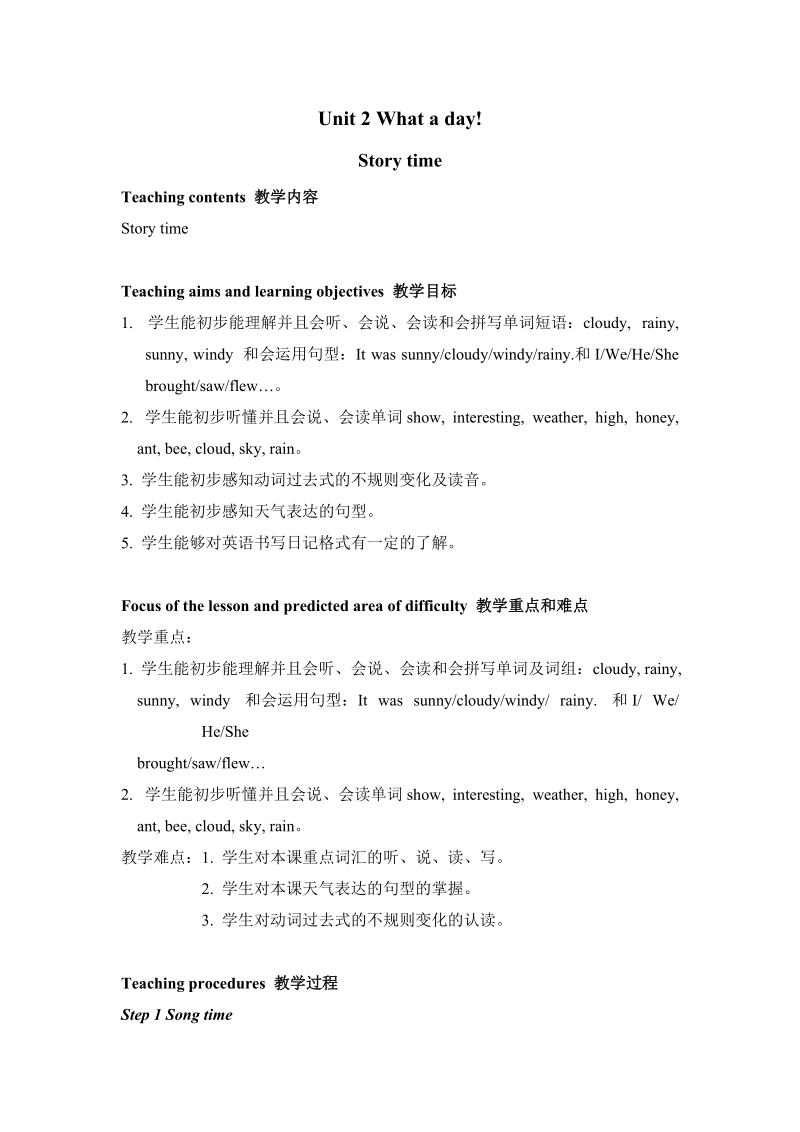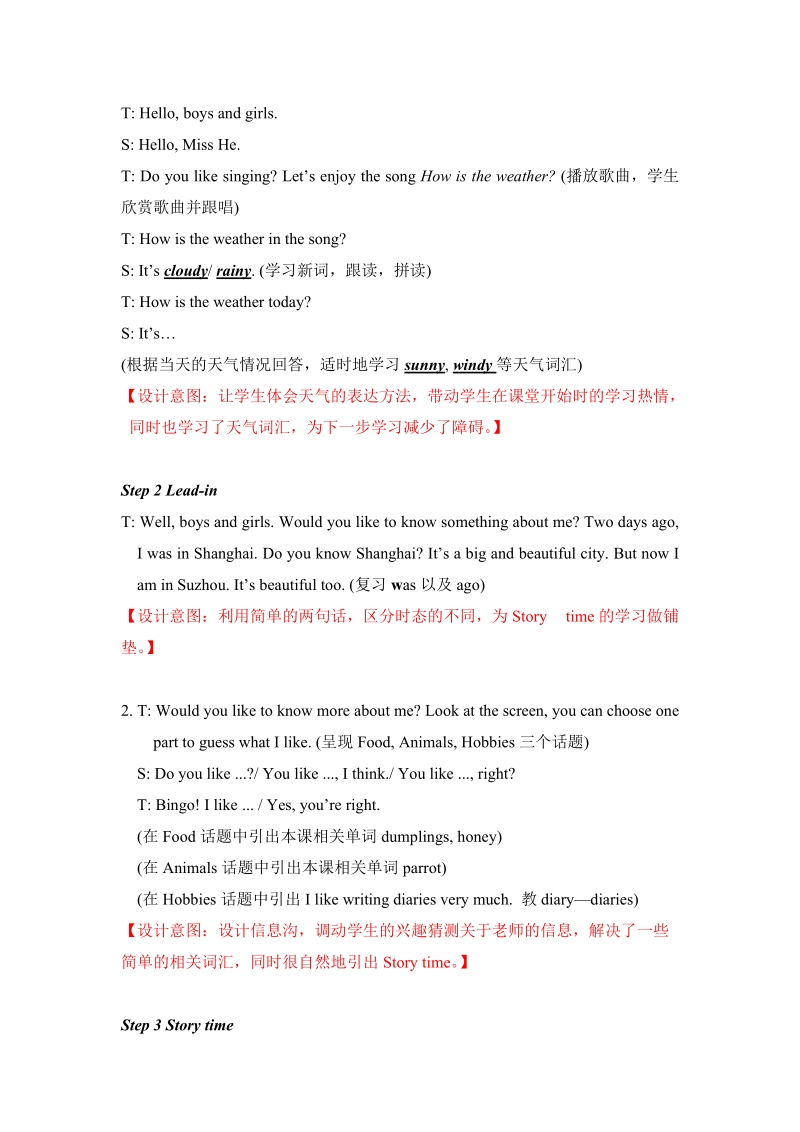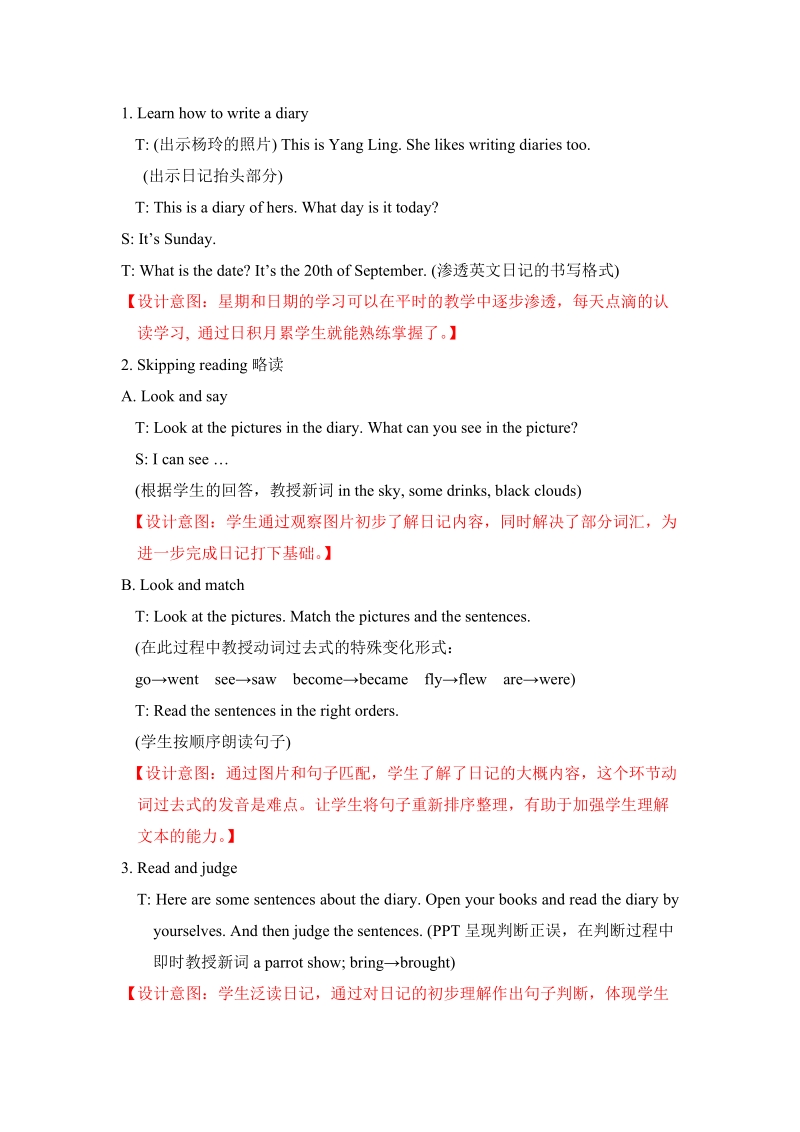 牛津译林版六年级上英语Unit2 Story time教案
牛津译林版六年级上英语Unit2 Story time教案
《牛津译林版六年级上英语Unit2 Story time教案》由会员分享,可在线阅读,更多相关《牛津译林版六年级上英语Unit2 Story time教案(6页珍藏版)》请在七七文库上搜索。
1、Unit 2 What a day!Story timeTeaching contents 教学内容Story timeTeaching aims and learning objectives 教学目标1. 学生能初步能理解并且会听、会说、会读和会拼写单词短语:cloudy, rainy, sunny, windy 和会运用句型:It was sunny/cloudy/windy/rainy.和 I/We/He/She brought/saw/flew。2. 学生能初步听懂并且会说、会读单词 show, interesting, weather, high, honey, ant, bee,
2、 cloud, sky, rain。3. 学生能初步感知动词过去式的不规则变化及读音。4. 学生能初步感知天气表达的句型。5. 学生能够对英语书写日记格式有一定的了解。Focus of the lesson and predicted area of difficulty 教学重点和难点教学重点:1. 学生能初步能理解并且会听、会说、会读和会拼写单词及词组:cloudy, rainy,sunny, windy 和会运用句型: It was sunny/cloudy/windy/ rainy. 和 I/ We/ He/She brought/saw/flew2. 学生能初步听懂并且会说、会读单词
3、 show, interesting, weather, high, honey, ant, bee, cloud, sky, rain。教学难点:1. 学生对本课重点词汇的听、说、读、写。2. 学生对本课天气表达的句型的掌握。3. 学生对动词过去式的不规则变化的认读。Teaching procedures 教学过程Step 1 Song timeT: Hello, boys and girls.S: Hello, Miss He.T: Do you like singing? Lets enjoy the song How is the weather? (播放歌曲,学生欣赏歌曲并跟唱)T:
4、 How is the weather in the song?S: Its cloudy/ rainy. (学习新词,跟读,拼读)T: How is the weather today?S: Its(根据当天的天气情况回答,适时地学习 sunny, windy 等天气词汇)【设计意图:让学生体会天气的表达方法,带动学生在课堂开始时的学习热情,同时也学习了天气词汇,为下一步学习减少了障碍。 】Step 2 Lead-inT: Well, boys and girls. Would you like to know something about me? Two days ago, I was
5、in Shanghai. Do you know Shanghai? Its a big and beautiful city. But now I am in Suzhou. Its beautiful too. (复习 was 以及 ago)【设计意图:利用简单的两句话,区分时态的不同,为 Story time 的学习做铺垫。 】2. T: Would you like to know more about me? Look at the screen, you can choose one part to guess what I like. (呈现 Food, Animals, Hob
6、bies 三个话题)S: Do you like .?/ You like ., I think./ You like ., right?T: Bingo! I like . / Yes, youre right.(在 Food 话题中引出本课相关单词 dumplings, honey)(在 Animals 话题中引出本课相关单词 parrot)(在 Hobbies 话题中引出 I like writing diaries very much. 教 diarydiaries)【设计意图:设计信息沟,调动学生的兴趣猜测关于老师的信息,解决了一些简单的相关词汇,同时很自然地引出 Story tim
7、e。 】Step 3 Story time1. Learn how to write a diaryT: (出示杨玲的照片) This is Yang Ling. She likes writing diaries too.(出示日记抬头部分)T: This is a diary of hers. What day is it today? S: Its Sunday.T: What is the date? Its the 20th of September. (渗透英文日记的书写格式)【设计意图:星期和日期的学习可以在平时的教学中逐步渗透,每天点滴的认读学习, 通过日积月累学生就能熟练掌握
8、了。 】2. Skipping reading 略读A. Look and sayT: Look at the pictures in the diary. What can you see in the picture?S: I can see (根据学生的回答,教授新词 in the sky, some drinks, black clouds) 【设计意图:学生通过观察图片初步了解日记内容,同时解决了部分词汇,为进一步完成日记打下基础。 】B. Look and matchT: Look at the pictures. Match the pictures and the senten



- 配套讲稿:
如PPT文件的首页显示word图标,表示该PPT已包含配套word讲稿。双击word图标可打开word文档。
- 特殊限制:
部分文档作品中含有的国旗、国徽等图片,仅作为作品整体效果示例展示,禁止商用。设计者仅对作品中独创性部分享有著作权。
- 关 键 词:
- 牛津 译林版 六年级 英语 Unit2Storytime 教案
 七七文库所有资源均是用户自行上传分享,仅供网友学习交流,未经上传用户书面授权,请勿作他用。
七七文库所有资源均是用户自行上传分享,仅供网友学习交流,未经上传用户书面授权,请勿作他用。
文档标签
- 泽林版英语书第4单元story time第六年级
- 牛津译林版六年级下英语Unit3 Story time 教案
- 牛津译林版六年级上英语Unit7 Story time课件
- 牛津译林版六年级上英语Unit1 Story time教案
- 牛津译林版六年级上英语Unit8 Story time教案
- 牛津译林版六年级上英语Unit7 Story time教案
- 牛津译林版三年级上英语Unit2 Story time教案
- 牛津译林版六年级下英语Unit4 Story time 教案
- 牛津译林版五年级上英语Unit2 Story time教案
- 牛津译林版六年级上英语Unit6 Story time教案
- 牛津译林版六年级上英语Unit2 Story time教案
- 牛津译林版六年级英语下册Unit2-story time课件
- 牛津译林版六年级上英语Unit1 Fun time
- 牛津译林版六年级上英语Unit5 Story time教案
- 牛津译林版六年级英语下册Unit8-story time课件
- 牛津译林版六年级英语下册Unit3-story time课件
- 牛津译林版六年级下英语Unit2 Story time 教案
- 牛津译林版六年级下英语Unit1 Story time 教案
- 牛津译林版六年级英语下册Unit2教案
- 牛津译林版六年级英语下册Unit6-story time课件



 浙公网安备33030202001339号
浙公网安备33030202001339号
链接地址:https://www.77wenku.com/p-86458.html